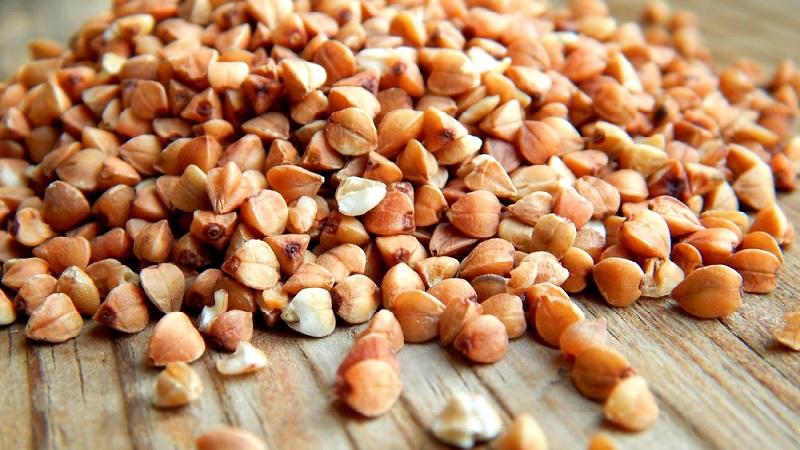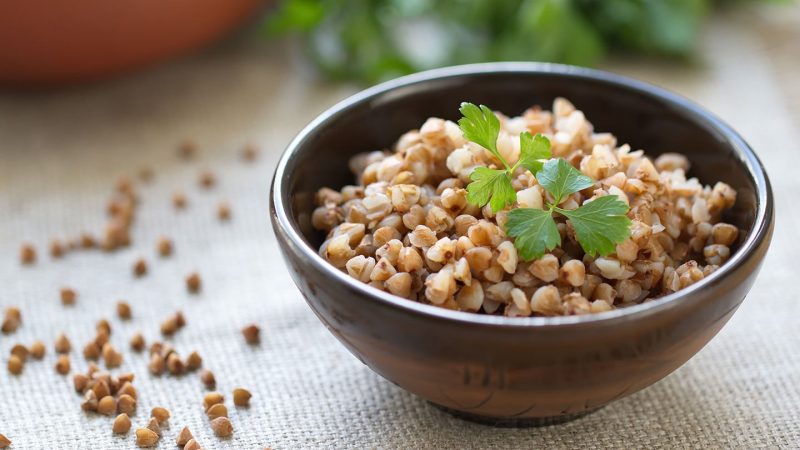Is it possible to use buckwheat while breastfeeding
Nutrition during lactation is an urgent problem for many young mothers: some products are prohibited, others are severely restricted. In the list of the little that is allowed for a nursing woman, a special place is given to buckwheat.
In the article, we will consider the beneficial properties of this cereal, find out the effect on the production of breast milk, possible restrictions and contraindications.
The content of the article
- Useful properties of buckwheat
- How buckwheat affects lactation
- Is it possible to eat buckwheat for a nursing mother
- Buckwheat consumption depending on the feeding period
- Rules for the introduction of buckwheat into the diet of a nursing mother
- Contraindications and possible consequences of use
- Pediatrician advice
- Conclusion
Useful properties of buckwheat

Buckwheat has a rich set of nutrients. Among them:
- rutin - has a positive effect on the state of the heart and blood vessels, in pharmacology it is used as a prophylactic agent against vitamin deficiency;
- lysine - is necessary for proper absorption of calcium;
- dietary fiber - normalizes the digestive process, gives a long-lasting feeling of satiety;
- copper - is responsible for the health of nails, skin and hair;
- calcium and phosphorus - building material for bone tissue;
- B vitamins - participate in metabolic processes, strengthen the nervous system.
Many women experience iron deficiency anemia after childbirth. Eating buckwheat will improve the condition, but it will not completely solve the problem, since cereals contain a non-heme form of a trace element - it is absorbed by the body worse than iron in animal products (liver, beef, turkey) and medications.
How buckwheat affects lactation
A balanced diet is required for stable lactation. Buckwheat is one of the first products introduced into the diet of a young mother immediately after childbirth.
The advantages of this cereal are its good digestibility, the absence of allergens (in particular, gluten) and the peculiarities of growing raw materials. So, when cultivating buckwheat, chemical fertilizers and pesticides are not used, and this is one of the few products that has not been subjected to genetic modification.
Whether buckwheat improves the quantity and quality of breast milk is not reliably known, however, there are no direct contraindications to its use. The positive effect on lactation is rather indirect - the nursing mother receives the necessary nutrients, and her body is ready to produce milk.
Is it possible to eat buckwheat for a nursing mother

It is not only possible, but also necessary to introduce buckwheat into the menu during the period of establishing breastfeeding.
Buckwheat porridge is hypoallergenic, gives a long-lasting feeling of satiety, does not cause sudden jumps in blood sugar and fermentation in the digestive tract. Thus, the mother may not worry that what she eats will turn into colic in the baby or cause him an allergy.
In any form
During cooking, the carbohydrates in the buckwheat composition are destroyed to practically useless starch, and the concentration of vitamins and minerals decreases sharply. To avoid this, it is better to steam the cereals: rinse thoroughly, pour boiling water in a 1: 2 ratio and leave overnight.
Another way to get a healthier product is to fry the grains in a dry hot skillet and then nibble on the grains like seeds.Many anemic people come to this recipe intuitively.
Important! In the first months of lactation, nutritionists advise avoiding whole milk, therefore buckwheat porridge with milk or butter is prohibited.
What
For the menu during lactation, choose kernel - whole grains of buckwheat. Done, flour and cereals can also be present in the diet, but solely for the sake of variety, since they are less useful.
To find out which cereal has undergone more processing, it is enough to compare the color: the darker brown buckwheat was fried or steamed longer - its chemical composition is poorer. A light beige hue is preferable - in terms of properties, it is closer to whole grain.
Reference. The popular green buckwheat is controversial among pediatricians. On the one hand, it has 30% more vitamins and minerals than brown. On the other hand, the product can cause indigestion in both mother and child.
Are there any alternative products
A fundamental rule of healthy eating is variety of foods. Therefore, buckwheat is sometimes replaced with alternative cereals. For example, rice or corn. However, be careful: rice can lead to constipation, and corn can lead to flatulence.
If porridge is causing these reactions, green or white vegetables such as courgettes, potatoes, cauliflower and broccoli are a great option. They can be steamed or stewed.
Buckwheat consumption depending on the feeding period
The older the baby, the more varied the menu of his mother becomes. Therefore, the nutrition of a nursing woman largely depends on the age of her child.
In the first month
In the first month after giving birth, the most severe restrictions are imposed on a woman's diet. The baby's digestive system is not yet sufficiently developed, the stomach lacks enzymes.
The main task during this period is to avoid allergens. As one of the safest foods, buckwheat forms the basis of the menu: it can be eaten for breakfast, added to soup and used as a side dish.
In the second
Mom's diet is gradually expanding, but many babies suffer from colic. High-carb foods can cause them. Therefore, vegetable stews are preferable instead of cereals. Buckwheat is allowed 3-4 times a week, 150-200 g per serving.
The third
The menu becomes even more diverse. As a side dish, buckwheat can be replaced with pearl barley and millet porridge, pasta, rice. New products introduce the baby to the variety of tastes and help the mother stay on the diet.
The fourth
As a rule, by the end of the third month, babies have colic, the need for a strict diet disappears... A woman can afford to eat as she wants (excluding alcohol and fast food). For example, add milk and butter to buckwheat porridge.
However, if the task is to lose weight gained during pregnancy, steamed buckwheat without salt and sugar in combination with low-fat kefir is a great way to regain slimness.
Rules for the introduction of buckwheat into the diet of a nursing mother

All products, including buckwheat, are introduced into the menu gradually. It is important to monitor the baby's reaction in order to identify allergens at an early stage and avoid them in the future.
A food diary will help with this: they write down what, when and in what quantity the mother ate and how this affected the child's well-being.
How often to use and in what form
They start eating buckwheat with a few tablespoons a day. If after a day there are no undesirable reactions in the baby (stool disturbance, bloating, redness), the portion is doubled. So the procedure is repeated until mom eats 150 g of buckwheat porridge a day.
The optimal frequency is 3-4 times a week, on other days the product is replaced with other cereals, pasta, potatoes.
Recipes with buckwheat for nursing
The neutral taste of buckwheat gives a wide field for culinary fantasies. Groats can serve as an independent dish, a side dish, a dressing for soups and even a dessert.
Buckwheat soup
We offer a lighter, leaner version of the dish. Optionally, you can use a second chicken or beef stock.
Ingredients:
- 1.5-2 liters of water;
- 100 g buckwheat;
- 2 potatoes;
- 1 carrot;
- 1 tbsp. l. vegetable oil;
- 1 bay leaf;
- salt and herbs to taste.
Preparation:
- Sort the groats and rinse until the water becomes clear. Peel and dice the potatoes.
- Send buckwheat and potatoes to boiling water. Cook for 15-20 minutes.
- Grate the carrots and simmer in vegetable oil until soft. Add to soup and leave over medium heat for another 5 minutes.
- Season the soup with salt and bay leaves. Let it brew.
- Serve with finely chopped herbs.
Buckwheat with beef and vegetables in a slow cooker
A nursing mother needs protein for sustainable lactation, and not only plant protein. During this period, beef is preferable - it acts as an additional source of well-assimilable iron.
The recipe saves time - they put ingredients in the multicooker bowl, set the mode and do other things while the device prepares the dish.
Ingredients:
- 250 g of beef;
- 1 tbsp. buckwheat;
- 1 carrot;
- 2 sweet peppers;
- 0.5 zucchini;
- 2 tbsp. l. vegetable oil;
- 2 tbsp. water;
- salt and herbs to taste.
Preparation:
- Wash, dry and cut the beef into small slices. Fry on vegetable for 10 minutes on the "Fry" mode, without closing the lid of the multicooker. Thanks to the resulting crust, the liquid will be "sealed" inside the pieces, and the meat will be more juicy.
- Add grated carrots, diced zucchini and bell peppers. Continue cooking in the "Fry" mode for another 5 minutes, but already covered.
- Pour sorted and washed buckwheat to the meat and carrots, add salt and water. Mix everything thoroughly. Depending on the model of the device, set the mode "Groats" or "Buckwheat" The approximate cooking time is 35 minutes.
- Add chopped greens 5 minutes before cooking.
This dish will be more useful if the meat is cooked separately from cereals - in this case, we halve the amount of water. Serve the finished beef with steamed buckwheat.
Steamed Greek people
These buckwheat cutlets with minced meat are good both hot and cold. Steamed Greek people are tender and dietary.
Ingredients:
- 1 glass of pre-steamed buckwheat;
- 500 g of turkey meat;
- 1 egg;
- salt to taste.
Preparation:
- Wash the turkey, cut into pieces. Grind the meat in a blender or mince it.
- Add buckwheat porridge, egg and salt. To stir thoroughly.
- Form the patties. To do this, pinch the minced meat with your hands soaked in cold water and beat it off a little, throwing it between your palms - this will help get rid of excess moisture and Greek people will keep their shape better.
- Put the cutlets in a double boiler or in a special multicooker dish. Cook for 30 minutes.
The turkey is a great substitute for minced chicken. For juiciness, you can add half a grated onion to it.
Buckwheat casserole with cottage cheese
This dish will not take long, but it will add variety to your usual diet. The casserole can be served for breakfast or afternoon tea.
Ingredients:
- 1 tbsp. steamed buckwheat;
- 200 g of cottage cheese;
- 2 eggs;
- 100 g sour cream;
- sugar, salt - to taste.
Preparation:
- Rub cottage cheese through a sieve, mix with ready-made buckwheat porridge.
- Beat the sour cream and eggs. Season with salt and sweeten to taste.
- Stir both masses and place in a baking dish.
- Cook in an oven preheated to 180 ° C for 15-20 minutes.
Baked apples with buckwheat
Such a dessert is allowed from 3-4 months of lactation, when the mother can afford a small portion of nuts and honey.
In the earlier period, you can do without these ingredients, but the dish tastes better with them.
Ingredients:
- 2 green apples (Antonovka, Granny Smith, Golden);
- 2-3 st. l. steamed buckwheat;
- 2 tbsp. l. chopped walnuts;
- 1 tbsp. l. raisins;
- 2 tbsp. l. honey.
Preparation:
- Soak the raisins in cold water.
- Wash and dry the apples.Using a teaspoon or a special tool, carefully remove the core.
- Mix buckwheat porridge with raisins, nuts and honey. Stuff the apples with the filling.
- Bake at 180 ° C for 30 minutes. The apples should look golden and the filling should be crispy.
Walnuts are one of the first to be introduced into the diet of a nursing mother (in 2-3 months of lactation), since they are less allergenic than hazelnuts, almonds and others. A handful of dried fruits a couple of times a week will not harm even at first.
Buckwheat milk
In the first couple of months of breastfeeding, whole cow's milk is prohibited. A buckwheat milk drink is a great alternative. It can be added to tea, cereals or drunk on its own.
Ingredients:
- 60 g green buckwheat;
- 300 ml of boiled water.
Preparation:
- Sort the groats and rinse, pour two glasses of clean cold water and leave to swell for 5-6 hours. You can do this overnight, but it is better to periodically change the water to fresh so that the cereal does not sour.
- Rinse the present buckwheat again. Let the water drain.
- Beat in a blender on high speed, adding in small portions boiled cold water.
- Strain the resulting mass through a sieve or double folded gauze. Buckwheat milk is ready.
- It can be stored in the refrigerator for no more than 12 hours.
Contraindications and possible consequences of use
Moderate consumption of buckwheat will not harm healthy people. But with a number of diseases, product abuse contraindicated:
- hepatic and renal failure;
- pancreatitis;
- stomach and duodenal ulcer in the acute stage;
- increased blood clotting.
Buckwheat is carefully introduced into the diet of diabetics and hypertensive patients. The starch in cereals increases glucose levels, and the ability to dilate blood vessels aggravates problems with blood pressure.
Important! As a rule, special dietary tables are prescribed for such patients. Talk to your doctor about any changes, including those related to breastfeeding.
Can buckwheat cause allergies or colic in a child?
Buckwheat does not contain gluten, therefore it belongs to hypoallergenic cereals. This is one of the recommended cereals for the first feeding of babies.
But in addition to gluten, other substances cause unwanted reactions. For example, the body can reject dietary protein (albumin, prolamine, globulin, glutelin, etc.). Buckwheat is 14-16% protein, so allergies to it are not as rare as it seems.
Together with breast milk, the baby also receives traces of those foods that the mother eats. At the same time, food can be well absorbed by a woman, but provoke an allergy in a baby, whose immune system has not yet been formed.
Typical symptoms: skin rash, watery eyes, conjunctivitis, indigestion, runny nose. When they occur, buckwheat and other possible allergens are excluded from the mother's diet.
Colic is the most common problem in infants. An immature digestive system is under tremendous stress, which leads to increased gas production. In addition to special exercises and carminative agents, this period will facilitate compliance with the diet of a nursing mother. Although buckwheat is well digested and contains less starch than many other cereals, excessive use of it provokes discomfort for both mother and baby. For this reason, it is important to observe the measure.
Pediatrician advice
In order for buckwheat to benefit the nursing mother and child, pediatricians advise adhering to the rules:
- daily rate - up to 150 g of ready-made porridge, frequency - up to three times a week;
- begin to introduce the product from a couple of tablespoons per day, gradually increasing the portion;
- the groats must be of high quality and within the shelf life;
- to remove impurities and spoiled grains, buckwheat is sorted;
- steamed porridge is healthier than cooked.
Conclusion
Buckwheat is an indispensable product during lactation: it contains a whole range of useful nutrients, is easily digested, affordable and easy to prepare. To avoid colic in a baby, eat buckwheat in moderation, alternate with other cereals, and combine wisely with plant and protein foods.
The surest way to prevent food allergies is to keep a food diary. So you can identify the allergen in the early stages and exclude it from the diet.